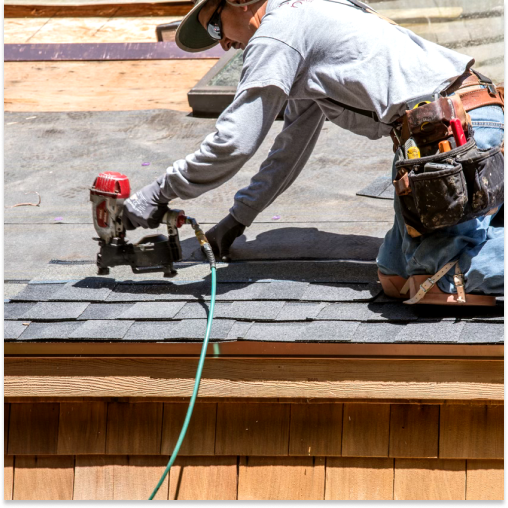Estimates are at the heart of the sales process for roofing contractors. In fact, accurate estimates ensure fair pricing, satisfied customers, and profitable projects. So, do your sales reps know how to estimate a roofing job properly?
In this guide, you’ll discover the ins and outs of the estimating process, from materials and pricing to labor and permits. And as a result, you can create consistent and professional estimates that help your business win more jobs and build more trust with homeowners.

What Is a Roofing Estimate?
In general, a roofing estimate is a detailed proposal provided to a homeowner that outlines the costs and scope of a roofing project. Moreover, a comprehensive estimate includes all project details to avoid misunderstandings.
For example, here’s what to include in a roofing estimate:
- Project Scope: Description of the work to be performed.
- Materials: Types and quantities of materials needed.
- Labor: Cost of the installation for your roofing crews.
- Timeline: Estimate of the start and completion dates for the project.
- Pricing: A detailed cost breakdown that considers all the factors above.
With the right systems in place, your sales reps will learn how to estimate a roofing job quickly. And with advancements in technology, you can eliminate common errors from your estimates that often lead to delays or cut into your profit margins.
How to Estimate a Roofing Job
During the estimating process, there’s a few key steps that cannot be overlooked. In addition, you must collaborate with the homeowner to ensure their concerns are addressed. Specifically, follow these steps when you estimate a roofing job:
- Conduct a Thorough Inspection: Assess the roof’s condition and collect key measurements and images.
- Define the Scope of Work: Detail all tasks required to complete the job.
- Select Materials: Choose appropriate materials based on the homeowner’s needs.
- Estimate Labor: Determine the number of workers, subcontractors, and time needed for the job.
- Outline the Timeline: Provide a realistic project timeline.
- Break Down Pricing: Include all costs, including materials, labor, and contingencies.
These key details will help the homeowner determine if your business is the right fit. Therefore, you want to make sure you present your estimates in a modern and professional manner.
With the right roofing sales software, you can quickly generate professional estimates with your branding. Furthermore, you can turn these estimates into contracts in a matter of clicks. It’s the perfect solution for sales reps to connect with homeowners and win more jobs for your business.
Unfortunately, many contractors don’t know how to estimate a roofing job with software solutions. So, let’s dig into the key elements of an estimate a bit further. That way you can utilize software to create precise estimates with every line item covered.
Project Scope of Work
The scope of work is a detailed description of the tasks required to complete a job. This section explains what will be done and how.
Overall, specify tasks such as removing old roofing, installing new materials, and repairing structures. Detail any additional services like gutter installation, solar, or attic insulation. A clear scope of work helps prevent misunderstandings and sets expectations for the job.
Materials and Products
The materials you choose affect how you estimate a roofing job. In fact, detail the type and quantity of materials and products for each project.
Include options like asphalt shingles, metal roofing, or tiles. Specify brand names and quality levels. Moreover, include information about warranties and lifespan. This will help to build trust with the homeowner as you provide more clarity over the products you are offering.
It’s also important to ensure you aren’t offering materials that are out of stock or no longer available. With a roofing CRM or sales software, you can integrate with suppliers to prevent these errors and generate product lists to get the estimate done more efficiently.
Labor and Subcontractors
Labor costs are a significant part of the estimate. Calculate the number of workers needed and your business rates.
Include subcontractors if necessary for specialized tasks. Detail their roles and responsibilities. Consider factors like skill level, experience, and local wage rates. Accurate labor estimates ensure you cover all costs. This is critical to making sure you aren’t underselling a job and cutting into your margins.
Project Timeline
The project timeline is the basis for planning and customer satisfaction. In fact, it’s one of the most important factors that a homeowner will consider before signing a contract. They want the work done right and on time.
Provide an estimated start and completion date. Include milestones for key tasks. Consider factors like weather, material delivery times, and crew availability. A realistic timeline helps manage expectations and project scheduling.
While delays can happen, the timeline gives the customer a clear forecast of the installation process. Therefore, they can plan accordingly as the job begins.
Breakdown of Pricing
We have now reached the line item that matters most. Overall, a detailed pricing breakdown should build trust with your customers, not push them away. New roofs or repairs can be expensive, but necessary. That’s why presentation is paramount when discussing pricing with the homeowner.
Include all costs: materials, labor, permits, and contingencies. Show calculations to explain how you got to that number. Transparency in pricing helps homeowners understand where their money is going. It also protects you from disputes and ensures profitability.
Additional Information for a Roofing Estimate
The details above are key items and necessary for every estimate. Yet, there is additional information that you may want to add, including contingencies, building codes, and permits.
Include a contingency plan for unexpected costs. Unforeseen issues like hidden damage can arise. Set aside a percentage of the total estimate for contingencies. This ensures you’re prepared for surprises without compromising your budget or timeline.
Local building codes and permits are also essential. Include the cost of permits in your estimate. Ensure your work complies with all regulations as well. This prevents legal issues and project delays. Mention any required inspections and their costs.
Improving Your Estimates
Accurate estimates require precise pricing control. And you can use sales software to manage your pricing database on the go. This software helps you track material costs, labor rates, and other expenses.
Implementing sales software streamlines the entire estimating process. It helps you generate accurate estimates quickly. Additionally, the software stores all necessary data and documentation. It can convert estimates into contracts in a matter of seconds. This saves time and reduces errors that are costing roofing contractors across the country.
The industry is changing and nothing has evolved more than the sales process. The way you connect with a homeowner couldn’t be more different. In fact, homeowners do their research and have access to more information than ever before. So, they know everything about your business before you walk through their door for the appointment.
As you can see, you must make every estimate count. And the best way to do that is through software solutions that resonate with homeowners and save everyone time and money.
How to Estimate a Roofing Job with Leap
Leap provides an industry-leading sales software, SalesPro, for roofing contractors to create estimates, work with homeowners, and generate and sign contracts. Moreover, you can send invoices and collect payments as well.
SalesPro is the all-in-one solution for the sales process. You can schedule appointments, quickly create professional estimates, and transform them into ready-to-sign contracts in no time at all. You can also offer financing directly within the application to close more deals.
Leap partners with various tools to give you a full-scale solution for your sales, such as measurement tools, lenders, suppliers, and manufacturers. Now you can make every lead count and scale your sales operations.
Finding the right software is essential for efficiency. And SalesPro can integrate with your current systems to make the transition easier for your business.
You now know how to estimate a roofing job effectively to impress homeowners and earn their trust. But you need the right tools to maximize your efforts! Fill out the form below and schedule a quick demo to learn more about SalesPro. Learn how you can become more competitive in your service area and grow your business with Leap.




